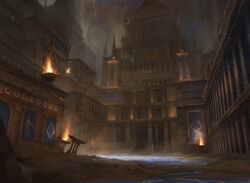Crypt of the Eternals
| Crypt of the Eternals | |
|---|---|
| The Great Necropolis | |
| Information | |
| Plane | Amonkhet |
| Colors |
|
| Part of | Shefet |
The Crypt of the Eternals embodied the God-Pharaoh's final promise to his devoted people. Hidden behind the sealed gate at the edge of Naktamun, it was here that the worthy dead were transformed into an immortal army, preserved for an age when their service would be called upon again. The necropolis stood as a silent, ominous reminder that death on Amonkhet was never truly the end — a reminder fulfilled during the Final Hours, when the crypt's secrets were unleashed to devastate the world.[1][2] [1]
Description
The Crypt of the Eternals was the grand necropolis of Amonkhet, hidden beyond the imposing Gate to the Afterlife that stood at the far end of Naktamun. The necropolis was a vast, labyrinthine complex stretching to a scale nearly equal to that of the living city of Naktamun. Inside its monumental chambers, countless rows of shelves and sealed vaults held ranks of immobile Eternals, each standing ready to be awakened at the God-Pharaoh's command.[1]
No living citizen of the city ever glimpsed its interior, for only the worthy dead were granted passage through the gate. When an initiate fell in the God Trials, their body was carried on a funerary barge drifting down the sacred waters of the Luxa river, destined to pass through the gate that would never open for the living.[1]
The gate itself opened solely to admit these solemn barges, each bearing the remains of a warrior who had proven themselves worthy through the trials. Once inside, anointed mummies received the bodies at the foot of the God-Pharaoh's massive Horn Monument, a towering symbol of his promised return. Within the necropolis, these tireless embalming priests performed the sacred rites of preparation, but the rites varied significantly depending on the deceased's status.[1]
Those who perished before the Trial of Zeal or who otherwise failed to demonstrate their worth were embalmed as the anointed — their bodies carefully preserved, wrapped in pristine white linen, and made ready to serve the living as caretakers, laborers, or attendants. The truly worthy dead, however, received far greater honor. Their corpses were coated in thick, gleaming layers of lazotep, a mystical blue mineral mined under the God-Pharaoh's command. They were then fitted with weapons and armor like those they had wielded in life and adorned with their treasured cartouches that marked their accomplishments. These transformed warriors, now known as Eternals, did not rest in peace but instead awaited a future purpose.[1]
While the Eternals lay dormant, anointed mummies continued to tend the necropolis day and night. They cleaned the bodies, polished the lazotep armor, and guarded the crypt against any threat that might disturb its silent legions. The people of Naktamun saw this hidden necropolis as the final promise of glory — a testament that those who proved themselves in life would stand forever among the God-Pharaoh's chosen, ready to march at his side when he returned to claim the world he had shaped in his image.[1]
History
During the Final Hours, the sealed gates finally swung open as foretold when the Second Sun aligned with the horns of the God-Pharaoh's monument. Rather than paradise, the people of Naktamun found themselves within only rows of tombs and an unyielding army of the Eternals. The necropolis became the origin of the Hour of Eternity, when the Scarab God led countless generations of lazotep-coated dead out from the crypt to transform Naktamun's people into an undead legion.[1]
What was once the promise of eternal glory revealed itself as a cruel lie: the worthy dead did not rest but rose again as flawless soldiers, stripped of memories yet retaining their martial skill. In the chaos that followed, the Scorpion God and Locust God joined the Scarab God in enacting Nicol Bolas's plan, with the Eternals flooding through the broken Hekma to slaughter the living. The Gatewatch, Hazoret, Samut, and the remaining faithful fought to repel the crypt's unleashed legions, but the Eternals' ranks seemed endless. Even after Bolas's departure, the crypt remained a grim monument to the God-Pharaoh's deception — its once-silent tombs forever changed into an unending army forged from the dreams and flesh of the people themselves.[2]
After the War of the Spark, Chandra Nalaar visited the crypt in the hopes of being able to overcome the trauma of Gideon's death. She destroyed a stay band of Eternals, and then obliterated the massive statue of Nicol Bolas inside the crypt.[3]
During New Phyrexia's invasion of the multiverse, it was opened by the Phyrexians.[4]
In-game references
- Represented in:
References
- ↑ a b c d e f g h James Wyatt (July 2017) - The Art of Magic: The Gathering - Amonkhet, Viz Media.
- ↑ a b Ken Troop (July 26, 2017). "Hour of Devastation". magicthegathering.com. Wizards of the Coast.
- ↑ Vita Ayala (2018-2019) Magic: The Gathering - Chandra, IDW Publishing.
- ↑ Unseal the Necropolis
